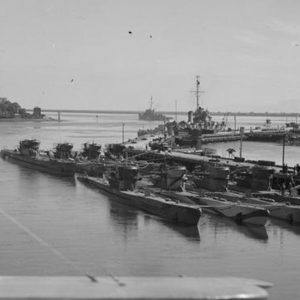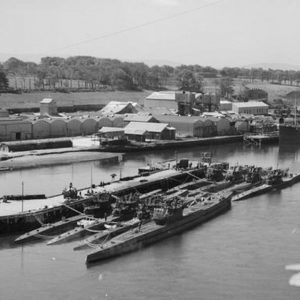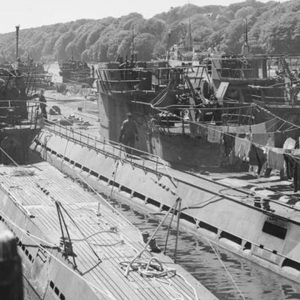On Monday 14th May 1945, 8 German U-Boats entered Lough Foyle bound for the Royal Naval jetty at Lisahally, Co. Londonderry. Rather than fear or panic in the maiden city, the mood was one of celebration. The port was not under attack. The fearsome Kriegsmarine had surrendered and brought an end to the Battle of the Atlantic.
Admiral Sir Max Horton oversaw the surrender. Although Horton’s base was at Derby House, Liverpool, England, it was he as Commander in Chief of the Western Approaches who chose the Co. Londonderry port as the historic site. The U-Boats flew the Royal naval White Ensign from their decks as British seamen kept an eye on the U-Boats’ skeleton crews passing Culmore Point.
The choice of a port in Co. Londonderry as the venue for the U-Boats’ surrender was significant. The area played an important role in the Battle of the Atlantic. Churchill had once called the U-Boats his “greatest fear”. Throughout the Battle of the Atlantic, they carried out attacks on Allied shipping, threatening to cut off supplies to Britain. Airfields and ports in Co. Londonderry were central to the Allies’ war on the U-Boat wolfpacks.
The importance of Co. Londonderry as a site of the United Kingdom’s westernmost port increased after the fall of France in 1940. H.M.S. Ferret came into existence in 1940. In the next 3 years, the number of ships passing through Lishally was greater than Liverpool, Glasgow, and Belfast combined. During this time, some of the Allies’ most famous U-Boat hunters served in Derry/Londonderry including Donald MacIntyre, Johnnie Walker, Peter Gretton, and Evelyn Chavasse. The Battle of the Atlantic raged on throughout the Second World War, lasting from the sinking of S.S. Athenia on 3rd September 1939 to the sinking of 2 ships in the Firth of Fourth on 7th May 1945.
Undefeated and spotless, you lay down your arms after heroic battle without equal.
Grand Admiral Karl Donitz – May 1945.
The Surrender
In total, more than 100,000 died during the Battle of the Atlantic before Hitler’s successor Grand Admiral Karl Donitz surrendered. Donitz instructed all U-Boat captains to surrender to the nearest Allied warship before raising a black flag. Most captains obeyed although some scuttled their own craft rather than surrender.
All U-boats. Attention all U-boats. Cease fire at once. Stop all hostile action against Allied shipping.
Grand Admiral Karl Donitz – May 1945.
H.M.S. Hesperus, H.M.C.S. Theford Mines, and U.S.S. Paine escorted those first 8 U-Boats into Lough Foyle. Oberleutnant Klaus Hilgendorf, commander of U-1009 lead the way. The 3 Allied vessels represented the British, Canadian, and American contributions to the Battle of the Atlantic. Admiral Sir Max Horton had flown over the Irish Sea from R.A.F. Speke, Lancashire, England to R.N.A.S. Eglinton, Co. Londonderry.
On the banks of the River Foyle, he joined a distinguished group including Prime Minister of Northern Ireland Sir Basil Brooke and Colonel Dan Bryan, the head of Irish Intelligence. This was a recognition that the effort in the Battle of the Atlantic was not only a British one. Sailors, airmen, soldiers, US Marines, and members of the Women’s Royal Navy from H.M.S. Ferret also attended. Airmen from Eglinton, Maydown, and Ballykelly and Royal Navy from H.M.S. Gannet and H.M.S. Shrike stood side by side.
On surrendering, the German U-Boat crews boarded trains and Allied forces escorted them to Prisoner of War Camps in Co. Down. By the end of the surrender, between 40 and 60 U-Boats stood docked at Lisahally, Co. Londonderry awaiting their destruction in Operation Deadlight.
As the U-Boats awaited their fate, locals had a chance to explore. Father Arthur O’Reilly was 13-years-old and taking a break from exam studies when an officer of the Royal Navy showed him around one of the submarines.
He allowed me to look through the periscope and I could see people walking on the quay. You could identify people. I was amazed at the technology. You could see people’s features.
Father Arthur O’Reilly – 2015
In 2015, the city of Derry/Londonderry marked the 70th anniversary of the surrender of the U-Boats at Lishally, Co. Londonderry. Displays included artifacts from the 1940s, photographs, and equipment including a U-Boat commander’s binoculars. Events took place across the city, in the Guildhall, the Tower Museum, and the Harbour House where re-enactors and tour guides brought the 1940s to life.
Among those to visit was 91-year-old Muriel Nevin. She had been at Lisahally with the Women’s Royal Navy in May 1945 and recalled her time with Canadian and American service personnel as well as a meeting with a U-Boat commander.
I quickly came over to Northern Ireland and was posted with the A36 and A37 Fleet Air Squadron in Maydown. The atmosphere was great. Everybody helped everybody, no matter who you were.
Muriel Nevin – Former WRNS at Maydown – 2015.
While other events of 1945 such as Victory in Europe Day or Victory in Japan Day are more widely celebrated, the surrender of the U-Boats was crucial to the Allies. Had the Nazis been victorious in the Battle of the Atlantic, the Allies would likely have suffered defeat. With the surrender of the U-Boats at Lisahally, the almost 6-year long Battle of the Atlantic, and the Second World War in Europe came to an end. The ports and airbases of Co. Londonderry can never downplay their role in securing that victory.





